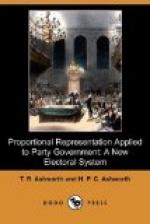That is the lesson we have endeavoured to inculcate throughout this book, and we are tempted to quote in support of it the opinion of an American author, Professor Paul S. Reinsch, in a work just published on “World Politics.” He says:—
The political experience of the last two centuries has proved that free government and party government are almost convertible terms. It is still as true as when Burke wrote his famous defence of party, in his Thoughts on the Cause of the Present Discontents, that, for the realization of political freedom, the organization of the electorate into regular and permanent parties is necessary. Parliamentary government has attained its highest success only in those countries where political power is held alternately by two great national parties. As soon as factional interests become predominant; as soon as the stability of government depends upon the artificial grouping of minor conflicting interests; as soon as the nation lacks the tonic effect of the mutual criticisms of great organizations, the highest form of free government becomes unattainable. (pp. 327, 328.)
The greatest strain on the Constitution will probably be felt at the outset. Both people and politicians are suddenly called upon to rise to a higher plane of political thought and action. The idea that each State is to send representatives to fight for its own interests must first be got rid of. The only way in which all interests can be reconciled is by each State acting through the national parties. The greatest danger which assails the Commonwealth is the risk of combinations of States dominating party lines; and it is the more imminent that divergent opinions between the larger and the smaller States were already apparent at the Convention. The four smaller States, Western Australia, South Australia, Queensland, and Tasmania, with about one-third of the population, will have two-thirds of the representation in the Senate; while the two large States, Victoria and New South Wales, will have about two-thirds of the representation in the House of Representatives. At the Convention the fear was expressed that the former, representing a majority of the States, and the latter, representing a majority of the people, might come into conflict, and that a deadlock would ensue. It was on this issue that the great struggle at the Convention took place, resulting in the adoption of a double dissolution and a subsequent joint sitting of the two Houses if necessary. By this machinery all disputes will be finally settled. But what will happen if some of the States consider themselves unjustly treated? Even apart from conflicts between the two Houses, if only one State stood aloof from the main parties it could paralyze government, just as Ireland did in the Imperial Parliament. It is evident, then, that the very existence of the Union is bound up in the immediate formation of national parties.
In the United States this lesson was not learned till the Civil War had demonstrated the danger of combinations of States. Since then two great parties have been maintained, even though their existence involves the spoils system and machine organization. In Switzerland, too, the federal tie was not drawn close till after the revolution in 1847, in which the Catholic cantons attempted to secede.




